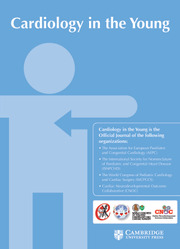No CrossRef data available.
Article contents
Modelling right and left ventricular adaptation over time after tetralogy of Fallot repair and the need for pulmonary valve replacement in adolescence
Published online by Cambridge University Press: 28 July 2025
Abstract
Progressive ventricular remodelling in children with repaired tetralogy of Fallot may or may not result in the need for pulmonary valve replacement. We aimed to model and compare the rates of right and left ventricular adaptation over time, as assessed by cardiac MRI after surgical repair of tetralogy of Fallot, in children who did or did not require pulmonary valve replacement later in adolescence.
Single-centre, retrospective cohort study from 2000 to 2020 including patients with tetralogy of Fallot who had complete surgical repair before 24 months.
From 214 patients included in this analysis, 142 (66.3%) had pulmonary valve replacement at a median age of 12 years (interquartile range 9–15.5) during follow-up. Assessing 323 cardiac MRI studies from 201 patients commencing from a median age of 9.4 years (interquartile range 5.9–12.3), the group that required pulmonary valve replacement later during the follow-up had a steeper time-related right ventricular dilation trajectory than non-pulmonary valve replacement patients: the increment in right ventricular end-diastolic volume index was 19.4 versus 2.8 ml/m2/log2year, P < 0.001; also, right ventricular end-systolic volume index incremented more quickly, at 11.9 versus 0.8 ml/m2/log2year, P < 0.001. Left ventricular end-diastolic volume index increased more quickly in patients who eventually had pulmonary valve replacement, at 7.2 versus 1.5 ml/m2/log2year, P = 0.005; the same occurred for indexed left ventricular end-systolic volume at 3.2 versus –0.4 ml/m2/log2year, P = 0.001.
Early right and left ventricular dilation over time are identifiable by cardiac MRI in patients destined to require pulmonary valve replacement following tetralogy of Fallot repair.
Keywords
Information
- Type
- Original Article
- Information
- Copyright
- © The Author(s), 2025. Published by Cambridge University Press


